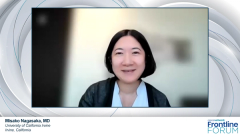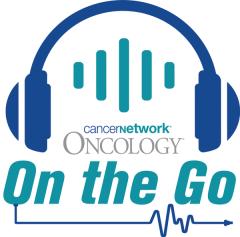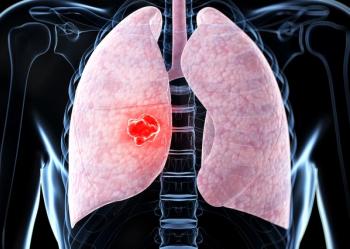
Paradigm of NGS Testing in Patients With Advanced NSCLC
Episodes in this series

Transcript:
Joshua K. Sabari, MD: Hello, and thank you for joining the Cancer Network® Frontline program titled Expert Perspectives in Testing and Targeted Therapy: Managing Patients With EGFR Exon 20 Insertion-Positive Non–small Cell Lung Cancer. I’m Joshua Sabari, a thoracic medical oncologist at NYU Langone Health Perlmutter Cancer Center in New York and joining me today is my esteemed colleague. I’d like to invite Dr Nagasaka to introduce herself.
Misako Nagasaka, MD: Hi, everyone. I am Misako Nagasaka from University of California, Irvine, and I do thoracic oncology. I’m happy to be here today.
Joshua K. Sabari, MD: Thank you, Dr Nagasaka, and thank you so much for joining me today. This program is an extension of a meeting that Dr Nagasaka and I had with a group of other expert faculty at ASCO [American Society of Clinical Oncology] 2023 to discuss key updates on the treatment of patients with exon 20 insertion mutant non–small cell lung cancer. In the next 30 minutes or so, Dr Nagasaka and I will share our insights on how these updates can be applied into clinical practice for patients with EGFR exon 20 mutant non–small cell lung cancer. So, Dr Nagasaka, let’s begin. Tell me a bit about next-generation sequencing and the revolution of targeted therapy in non–small cell lung cancer.
Misako Nagasaka, MD: Yes. It’s certainly an exciting time to be a thoracic oncologist. We have so many targets that are available, and it’s become very important to try to find these targets. So, at the time of advanced metastatic stage diagnosis, I do both tissue- and liquid-based NGS [next-generation sequencing] to determine these alterations, to see if I can find anything that I could target. What is your practice?
Joshua K. Sabari, MD: It is impressive, and I completely agree. You know, thinking about seeing a new patient in the office, there are so many options of therapeutics that can benefit patients. One of the key things we get back and [I’m] curious [about] in your practice is the PD-L1 expression, and you know, we’re itching to use the PD-1 or PD-L1 inhibitors based upon that. It’s critical to wait for the next-generation sequencing, as you mentioned, which opened up a whole other array of therapeutics for our patients, particularly the targeted therapeutics. And how long does that take you to get back in your practice, Dr Nagasaka?
Misako Nagasaka, MD: I send them out. And for the liquid it takes about 7 to 10 days, and for tissue it takes about 2 to 3 weeks. And it is certainly a bit frustrating at times that not having these results back quick enough. But I still try to emphasize the importance of waiting for these and not just jumping onto the PD-L1 score, which you usually get back in like 3 to 5 days or even less, just because I believe it’s important to make sure we connect the right treatment to the right patients.
Joshua K. Sabari, MD: I couldn’t agree more. In our practice also, it takes us, 2 to 3 weeks to get back tissue-based NGS, and we do an in-house panel that is not reflexive. We have to order it. So, it’s really 2 to 3 weeks from the time point that we order it. Oftentimes, when I meet a new patient, I don’t have that information back yet. And I agree with you. Liquid biopsy has been extremely helpful in the turnaround time, on average about 5 to 7 days in our clinical practice. So, Dr Nagasaka, you mentioned that you order, you know, NGS on all patients upfront, for identification of somatic alterations. Do you ever order NGS other times in patients’ treatment paradigm?
Misako Nagasaka, MD: Absolutely. For example, if I have a patient who comes to me for a second opinion, and maybe they have already been on firstline or second-line treatment, I always review whatever was done initially at the time of their advanced metastatic stage diagnosis. I look at the molecular testing report. But if I get a report that wasn’t a comprehensive one, that didn’t use NGS, I reorder it at that time because I don’t want to be missing anything. What about you, Josh?
Joshua K. Sabari, MD: I agree with you. I’m using both plasma, as well as DNA-based NGS up front. And as you mentioned, some DNA-based assays could miss some alterations, particularly some of the fusions. And I sometimes do repeat, in the second-line setting. But clearly, when someone’s on a targeted therapy, we want to understand acquired resistance, and we’ll talk briefly about that when we mention some of the inhibitors down the road. And there I find it helpful to repeat testing. First, I use plasma and then usually following up with tissue-based NGS. Dr Nagasaka, in your practice, are you doing these together up front, tissue and plasma? And is it ever sufficient enough to just do plasma alone when you meet a new patient with stage IV non–small cell lung cancer?
Misako Nagasaka, MD: Those are great questions. I tend to order them both at the same time. One could argue that you could save tissue for later or maybe for clinical trials if you get a positive result on the liquid biopsy. But a negative liquid biopsy does not rule out [a] patient having possible targets. So, in that case, even if the liquid is negative, I tend to wait for the tissue results.
Joshua K. Sabari, MD: I couldn’t agree more, and I always mention going fishing. If you go fishing and don’t catch a fish, you don’t conclude that there is no fish in the ocean. Same with plasma NGS, with, you know, circulating tumor DNA. If you don’t identify it in the plasma, it doesn’t mean that it’s not there. So, false negative rates could be as high as 30%, 40%. Really, you need to fall back on the tissue-based NGS. But if you identified in the plasma, I couldn’t agree more, I act upon it. So, lots of barriers for testing in the frontline setting. Tissue acquisitions, sufficient tissue. We mentioned turnaround time already. And we know in community practice, you know, broad-panel NGS occurs at about only 50% to 60% of eligible patients. So, what are some of the strategies that you can think of or recommend for improving testing rates for broad molecular biomarkers in non–small cell lung cancer?
Misako Nagasaka, MD: Education is key, both at the provider, physician level, as well as patient level. I know that patients are very eager to get started on treatment. But knowing that they could have options based on their genomic mutations, that’s important. So, education is key here.
Joshua K. Sabari, MD: Couldn’t agree more. And then, also, education, education, education. But if we can remove this responsibility from a human and have this done reflexively, all patients would have NGS testing. Can you imagine, Dr Nagasaka, a breast cancer patient...
Misako Nagasaka, MD: Just like breast cancer, right?
Joshua K. Sabari, MD: Yes. Not having ER [estrogen receptor], PR [progesterone receptor]…
Misako Nagasaka, MD: ER, PR…
Joshua K. Sabari, MD: So, we need to move to that paradigm in non–small cell lung cancer.
Misako Nagasaka, MD: I agree.
Joshua K. Sabari, MD: Excellent discussion. And doing broad-panel NGS in all patients is critical upfront, but more importantly, not just to order the test, but to wait for the results so that you can actually act upon it and provide patients with the best possible therapy in their line, the frontline setting.
Transcript edited for clarity.
Newsletter
Stay up to date on recent advances in the multidisciplinary approach to cancer.






















































































